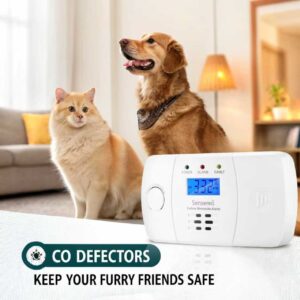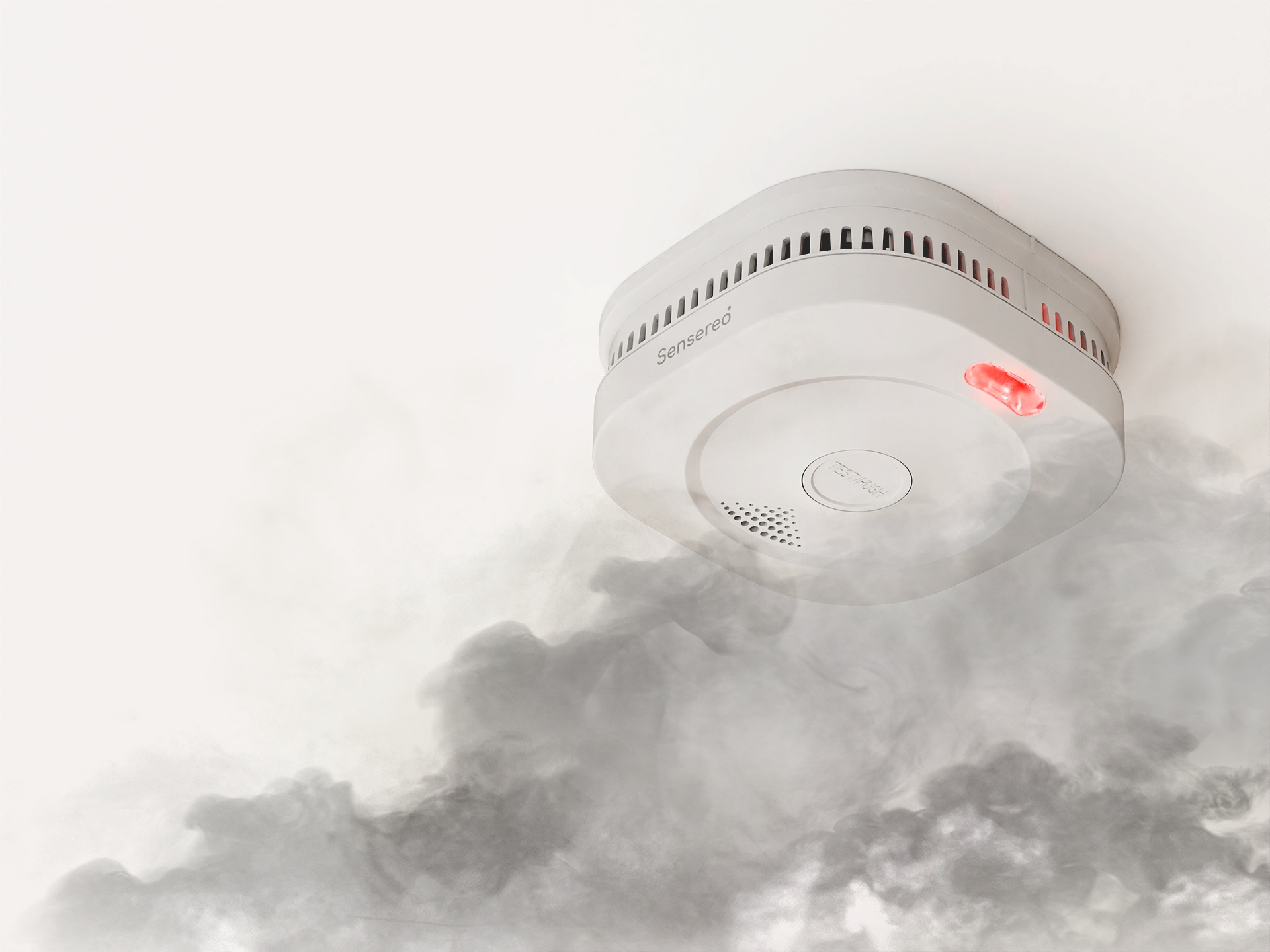Brief Summary:
A dependable, well-maintained standalone carbon monoxide detector is necessary to protect pets from CO poisoning. Pets are more susceptible to CO and frequently exhibit symptoms sooner than people because of their smaller stature and quicker metabolism. Prioritize models with a digital display for early detection when selecting the best carbon monoxide detector, and make sure it is positioned correctly close to pet living areas. Testing your device frequently is essential, and CO detector units should be replaced every five to seven years. Evacuate right away with your entire family, including your pets, if you notice your carbon monoxide detector going off.

CO Detectors for Pets: Keep Your Furry Friends Safe
Carbon monoxide (CO) poisoning is a silent killer that affects pets even faster than humans. As a pet owner myself, I learned this the hard way when my dog Bella nearly became a victim of CO exposure. That’s why choosing the suitable carbon monoxide detector is potentially life-saving for your furry family members.
“A quality CO alarm is the least expensive life insurance you’ll ever buy for your pets.”
Why Pets Are More Vulnerable to CO
Three critical reasons pets face greater danger:
- Metabolic differences (dogs process CO 3x faster than humans)
- Behavioral factors (pets can’t open windows or leave dangerous areas)
- Physical traits (cats’ smaller lungs absorb toxins more quickly)
Pro Tip: Place detectors at pet level (12-24 inches off the floor) for optimal protection.
What are warning signs of carbon monoxide poisoning
Carbon monoxide poisoning can have subtle warning signs that are frequently confused with other common illnesses, such as the flu.
These symptoms in humans include fatigue, confusion, nausea, dizziness, and a dull headache. However, because pets are smaller and have a faster metabolism, the symptoms may manifest sooner. Keep an eye out for signs such as fatigue, appetite loss, breathing problems, and a general lack of coordination. Any of these signs in humans or animals is a clear sign of a potentially harmful CO leak. This demonstrates the importance of having a working carbon monoxide detector. Before these physical symptoms even appear, it gives a clear, audible warning.
A Checklist for Pet Owners
Protecting pets necessitates taking preventative measures because they are frequently more vulnerable to carbon monoxide (CO) than people. This is a concise, doable checklist to safeguard your feathered and furry family members from this unseen danger.
Step 1: Choose the Best Carbon Monoxide Detector
Select a high-quality, reliable standalone carbon monoxide detector for your home. Seek out models that have a digital display that shows the CO level in real time. Because it can detect low-level CO concentrations before they become hazardous to humans, this feature is especially helpful for pet owners because it enables you to take prompt action to safeguard your animals.
Step 2: Verify Appropriate Positioning
Throughout your house, place your carbon monoxide detectors in strategic locations. Consider installing one in any space where your pet spends a lot of time, like a living room or basement, in addition to near bedrooms and fuel-burning appliances. This guarantees that you can hear the alarm and that it can identify an issue near your pet’s location.
Step 3: Follow a Strict Maintenance Schedule
A non-functional detector is useless. Make it a habit to test your alarms monthly by pressing the test button. It’s also critical to know when to replace CO detector units—the sensors inside degrade over time, and most manufacturers recommend replacement every 5 to 7 years. Check the date on the back of your detector and mark it on your calendar.
Step 4: Know What to Do When the Alarm Goes Off
Your carbon monoxide detector going off is a critical emergency signal. If you hear the distinct beeping of the alarm, immediately get every person and every pet out of the house and into fresh air. Do not re-enter the home for any reason. From a safe location, call 911 or your local fire department for assistance.
Finally, please pay attention that winter is the most dangerous season for carbon monoxide poisoning, as home furnaces and other heating systems run around the clock. A malfunction or crack in a flue pipe can quickly become a silent threat. It is crucial to have a professional inspect your heating systems and ensure your carbon monoxide detector is fully functional before the cold sets in.
How to Choose a Pet-Safe Carbon Monoxide Detector
When selecting the best carbon monoxide detector for a home with pets, you should prioritize specific features that offer enhanced protection for your more vulnerable family members. A quality standalone carbon monoxide detector will include these key features:
- A Clear Digital Display: This is the most crucial feature for pet owners. It shows real-time CO levels in parts per million (PPM), allowing you to monitor even minor changes in air quality and take action before your pets show any physical symptoms.
- A Loud, Distinct Alarm: The alarm should be loud enough to wake both you and your pets. When your carbon monoxide detector going off with a continuous, loud beeping, it’s a clear signal to evacuate immediately.
- Advanced Sensor Technology: Modern detectors offer greater accuracy and are less prone to false alarms. Look for UL 2034 certified models to ensure reliability.
- A Limited Lifespan Indicator: All CO sensors degrade over time. The best carbon monoxide detector will have an end-of-life indicator. Be sure to follow the manufacturer’s guidance and replace CO detector units every 5 to 7 years to maintain peak performance and safety.
To find a reliable model that meets these standards, consider the Sensereo Standalone Carbon Monoxide Detector (C-1). It features a highly sensitive electrochemical sensor for accurate, early detection, helping you safeguard every member of your family.

Maintenance and Replacement of CO Detectors
The majority of detectors last five to seven years. Indications that your CO detector needs to be replaced:
Regular false alarms
Chirping at the end of life (often every 30 seconds)
The monthly test (click the test button) failed!
Upkeep Hack: Use pet stickers to remind yourself of the replacement dates on your calendar.
Click here for more information: https://sensereo.com/community/when-to-replace-your-carbon-monoxide-detector-a-complete-guide/
Complete Pet Protection: Beyond Detectors
After interviewing home safety experts, I implemented these extra precautions:
- Ventilation checks – Install CO monitors near pet beds and gas appliances
- Appliance inspections – Annual furnace checks by certified technicians
- Pet-free zones – Keep animals away from garages and utility rooms
Bonus: Consider combo smoke/CO detectors with pet-friendly alarm tones.
Frequently Asked Questions
Q: Can pets sense carbon monoxide?
A: No, just like humans, pets cannot see, smell, or taste carbon monoxide. A functional standalone carbon monoxide detector is the only reliable way to alert you to its presence and keep your entire family, including your animals, safe.
Q: Is the smell of gas harmful to cats?
A: The smell of gas indicates a leak, which is extremely dangerous and requires immediate action. While the odorant in natural gas is not the same as carbon monoxide, a gas leak can displace oxygen and pose a severe fire or explosion risk. Always treat the smell of gas as a serious emergency and get out of the house.
Q: What are two warning signs of carbon monoxide poisoning?
A: In humans, two common early warning signs are a dull headache and dizziness. For pets, two key indicators are unusual sluggishness or lethargy and a lack of coordination, which may look like a sudden inability to stand or walk properly.
Q: Where is the best place to put a carbon monoxide detector?
A: The best carbon monoxide detector placement is near sleeping areas, on every level of your home, and near fuel-burning appliances like furnaces. For homes with pets, it’s also a good idea to place a detector in the rooms where your pets spend most of their time. Place detectors at chest height, as CO mixes evenly with air.
Q: Do humans exhale carbon monoxide or carbon dioxide?
A: Humans primarily exhale carbon dioxide (CO2). A carbon monoxide detector is specifically designed to detect carbon monoxide (CO), which is a completely different gas and a product of incomplete combustion from a faulty appliance, not from the human body.
“Don’t wait until it’s too late. Upgrade your standalone carbon monoxide detector today and sleep easier knowing your furry friends are protected.”



